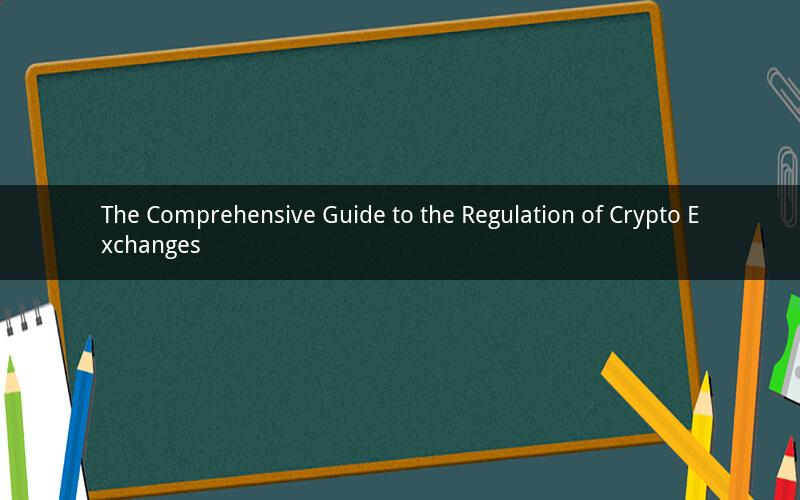
The rise of cryptocurrencies has brought with it a host of opportunities and challenges. One of the most pressing concerns for investors and regulators alike is the question of whether crypto exchanges are regulated. This article delves into the complexities surrounding the regulation of crypto exchanges, exploring the varying approaches taken by different countries and the implications for the industry.
1. What are crypto exchanges?
Crypto exchanges are online platforms that allow users to buy, sell, and trade cryptocurrencies. They facilitate the exchange of digital currencies for fiat money or other digital currencies. Users can create accounts, deposit funds, and place orders to buy or sell specific cryptocurrencies.
2. Why are crypto exchanges regulated?
The primary reason for regulating crypto exchanges is to protect consumers and prevent financial crimes such as money laundering, fraud, and market manipulation. Regulators aim to ensure that exchanges have proper safeguards in place to protect users' funds and personal information.
3. Are crypto exchanges regulated in all countries?
No, crypto exchanges are not regulated in all countries. The extent and nature of regulation vary significantly depending on the jurisdiction. Some countries have implemented comprehensive regulatory frameworks, while others have taken a more lenient approach.
3.1. Countries with strict regulation
Countries like the United States, Japan, and South Korea have implemented strict regulations on crypto exchanges. These countries require exchanges to obtain licenses, comply with anti-money laundering (AML) and know your customer (KYC) requirements, and report suspicious transactions.
3.2. Countries with lenient regulation
In contrast, countries like Switzerland, Singapore, and Malta have adopted a more lenient approach to regulating crypto exchanges. They provide a supportive environment for the industry, with minimal regulations and a focus on innovation.
4. The implications of crypto exchange regulation
The regulation of crypto exchanges has several implications for the industry, including:
4.1. Increased security
Regulation can lead to increased security measures, such as cold storage for cryptocurrencies, multi-factor authentication, and insurance for user funds. This can help protect users from hacks and theft.
4.2. Improved liquidity
Strictly regulated exchanges are more likely to attract institutional investors, which can lead to increased liquidity and lower trading fees.
4.3. Enhanced trust
Regulation can help build trust in the industry, as users are more likely to feel confident in using exchanges that comply with regulatory requirements.
4.4. Potential for market manipulation
While regulation can prevent financial crimes, it can also create opportunities for market manipulation. Regulators must strike a balance between protecting users and ensuring a fair and transparent market.
5. The future of crypto exchange regulation
The future of crypto exchange regulation is uncertain, but several trends are emerging:
5.1. Increased international cooperation
Regulators are increasingly working together to combat financial crimes and ensure a level playing field for crypto exchanges.
5.2. The rise of decentralized exchanges
Decentralized exchanges (DEXs) are gaining popularity as an alternative to traditional centralized exchanges. These platforms are not subject to the same regulatory requirements, which could lead to a shift in the industry.
5.3. The development of regulatory sandboxes
Regulatory sandboxes are becoming more common, allowing crypto exchanges to test new products and services in a controlled environment.
5.4. The potential for a global regulatory framework
The International Organization of Securities Commissions (IOSCO) is working on developing a global regulatory framework for crypto exchanges. This could lead to more consistent and comprehensive regulations across different jurisdictions.
In conclusion, the regulation of crypto exchanges is a complex and evolving issue. While some countries have implemented strict regulations, others have taken a more lenient approach. The implications of regulation are significant, and the future of the industry will depend on how regulators balance the need for security and innovation.
Questions and Answers:
1. Q: What is the primary goal of regulating crypto exchanges?
A: The primary goal of regulating crypto exchanges is to protect consumers and prevent financial crimes such as money laundering, fraud, and market manipulation.
2. Q: Are crypto exchanges regulated in the European Union?
A: Yes, the European Union has implemented regulations for crypto exchanges, known as the Markets in Crypto-Assets (MiCA) Regulation. This regulation aims to create a harmonized framework for crypto exchanges across the EU.
3. Q: How do crypto exchanges comply with AML and KYC requirements?
A: Crypto exchanges comply with AML and KYC requirements by implementing policies and procedures to verify the identity of users, monitor transactions for suspicious activity, and report suspicious transactions to the relevant authorities.
4. Q: What is the difference between a centralized and decentralized exchange?
A: A centralized exchange is a platform that is owned and operated by a single entity, while a decentralized exchange operates on a blockchain network and does not require a central authority. Decentralized exchanges are considered more secure and transparent but may have lower liquidity.
5. Q: Can crypto exchanges be regulated at a global level?
A: While there is no global regulatory framework for crypto exchanges yet, efforts are being made to develop one. The International Organization of Securities Commissions (IOSCO) is working on a global regulatory framework that could lead to more consistent and comprehensive regulations across different jurisdictions.